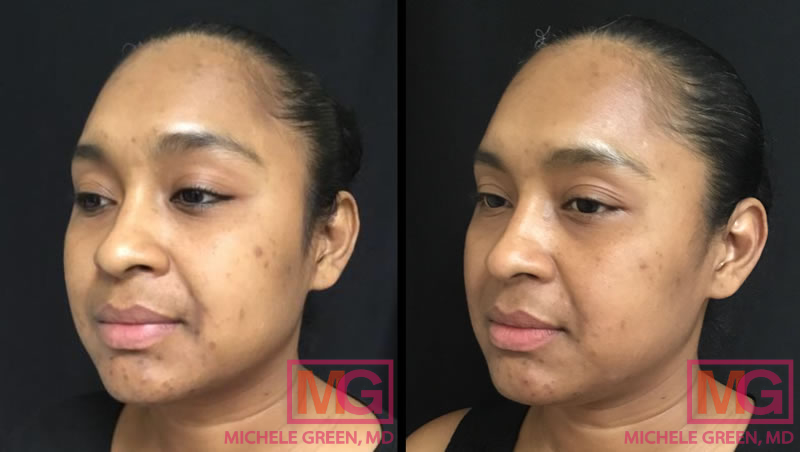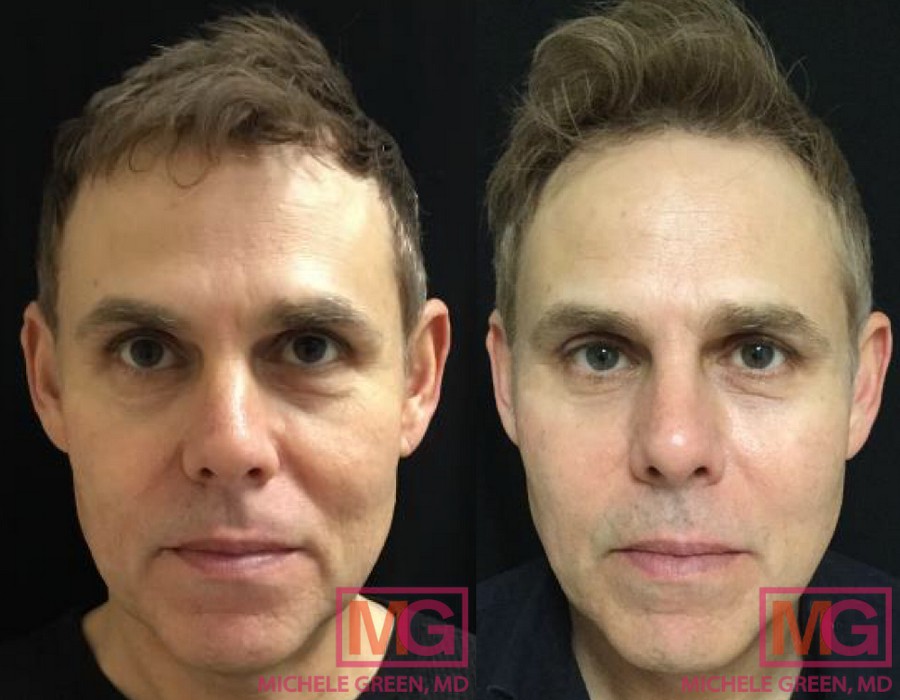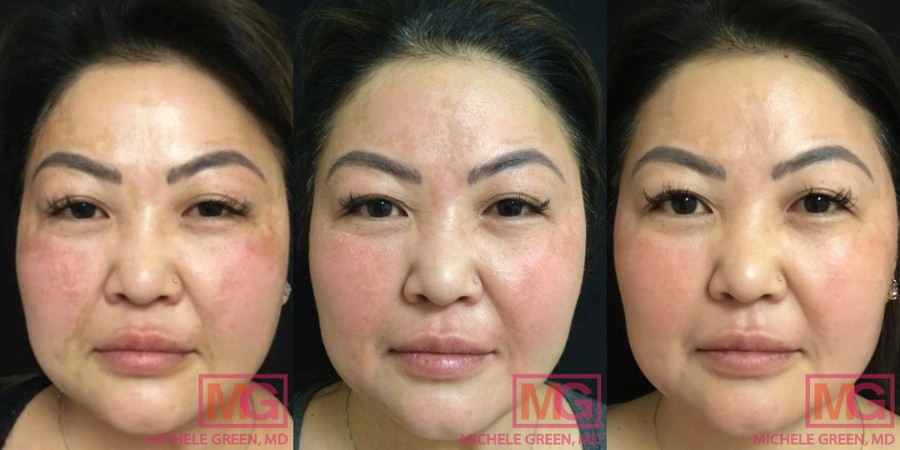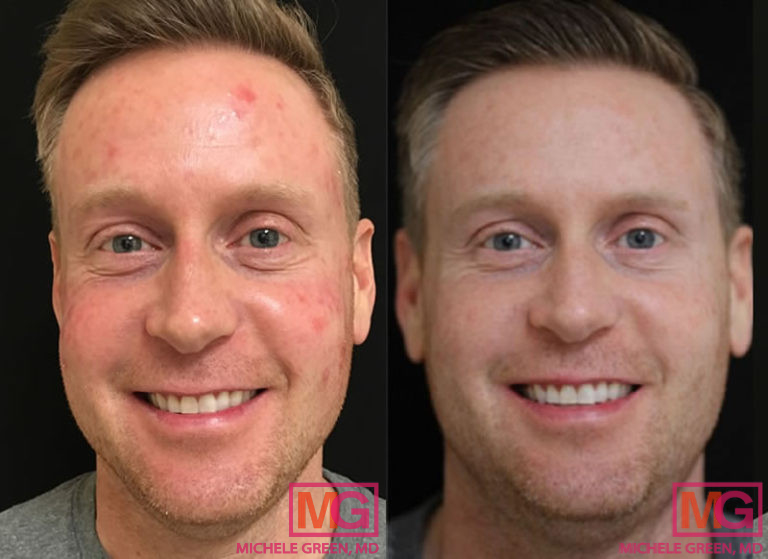Acne Scar Discoloration Treatment
Anyone who has experienced a bad acne breakout knows the sigh of relief that comes when a breakout has cleared. However, for many, lingering discoloration or acne scarring on the skin can make a clear complexion feel like a distant dream. Thankfully, there are a variety of different treatments that can help to reduce the appearance of discolored scar tissue, and help you to feel comfortable in your skin again.
If you’re frustrated by the appearance of skin discoloration caused by blemishes, acne scars, sun spots, or aging, board-certified dermatologist Dr. Michele Green is here to help. Dr. Michele Green is an expert in NYC in acne scars and skin discoloration. With the latest innovations in skincare, lasers, chemical peels, and laser treatments for acne scars and acne, Dr. Green is known as one of the best dermatologists in New York. With over 25 years of experience in cosmetic dermatology, developing the best skincare and treating hyperpigmentation and discoloration is a true passion of Dr. Green.

Acne scar treatment / hyperpigmentation – 1 month
Do you experience discoloration from acne scars?
Discoloration due to acne scarring is a common experience that patients go through, and the term “acne scars” refers to a variety of different marks on the skin that can appear after an acne breakout dissipates. Many patients experience temporary discoloration, known as post-inflammatory hyperpigmentation, which appears as dark spots that are typically flat on the skin, and can develop while the skin is healing the area around a former blemish. Other patients end up with tissue damage after an acne breakout, which can lead to atrophic scars, or small indentations on the skin. In some cases, patients can have overactive collagen production within the skin’s healing process, which can lead to hypertrophic scars or keloids.
While post-inflammatory hyperpigmentation can often be treated with over-the-counter skincare products, atrophic scars can greatly benefit from in-office skin treatments. Additionally, patients who have keloids (which are more commonly seen in patients with darker skin) should be careful to avoid treatments that cause any mild trauma to the skin, such as chemical peels or microneedling. Dr. Green works very carefully with patients who are dealing with keloids or hypertrophic scars to make sure that the scar can be reduced or removed without causing further damage to the skin.
What’s the Difference Between Traditional Acne Scars and Post-Inflammatory Hyperpigmentation?
Post-inflammatory hyperpigmentation (PIH) is a common symptom that patients experience after an acne breakout and, thankfully, does not create a permanent scar on the skin. PIH or erythema (persistent red spots that occur after an active acne lesion disappears) can develop on patients of any skin type, but it does tend to affect patents with medium to dark skin tones more severely. It develops commonly when a wound or irritation (including a pimple, scratch, or sunburn) inflames the skin. The natural wound-healing process of the skin can lead to an increase of melanin, the source of pigment in the skin. For this reason, post-inflammatory hyperpigmentation can appear on the skin in a variety of colors, including red, brown, or purple. Though the excess melanin darkens or discolors the skin, the skin is not permanently damaged. PIH can take between 3 months to two full years before it fully disappears on its own, but it can be treated to speed up the healing process.
Acne scars, on the other hand, are permanent scars that occur either due to a loss of tissue, which leads to an atrophic scar (such as a rolling, boxcar, or ice pick scar), or an overgrowth of tissue, which leads to a hypertrophic scar or keloid. While dark marks from PIH naturally fade over time, acne scars typically require a dermatological treatment plan that uses a combination of skincare treatments and in-office procedures.
Does acne discoloration go away?
For patients with post-inflammatory hyperpigmentation, acne discoloration can fade over time. However, “time” is the key word. Patients often seek out treatment for acne discoloration after a few months when the dark mark on the skin just won’t go away. There are many simple skincare treatments, either regiments maintained at home or procedures in-office, that can help to eliminate PIH from the surface of the skin, as well as prevent further appearances of acne discoloration.
For patients who experience atrophic scarring or small indentations on the skin, acne discoloration is very unlikely to go away on its own. For this reason, the world of dermatology has developed a variety of in-office treatments that can help to increase cell turnover, thus improving the health and appearance of the surface of the skin.
For patients with hypertrophic scars or keloids, working with a dermatologist is highly recommended in order to address the scarring without irritating the surrounding skin. Dr. Green frequently works with patients to develop treatment plans for hypertrophic scars that include traditional steroid injections, VBeam laser sessions, and at-home skin care regimens. In rare cases, surgical scar revision may be recommended, but typically non-invasive procedures can help to reduce the appearance of hypertrophic scars without a risk of further scarring.

eMatrix, Restylane and Sculptra for Acne Scars in Nasolabial area
How to get rid of acne scars
Acne scars can be removed or reduced by a variety of methods. First, doctor-recommended skin care products can be a highly effective treatment for patients dealing with post-inflammatory hyperpigmentation. Additionally, in-office treatments such as microneedling, laser skin resurfacing (like the VBeam laser or Fraxel Dual Laser), chemical peels, and steroid injections can all be effectively applied to reduce the appearance of atrophic and hypertrophic scars. Typically, patients opt to develop a treatment plan that uses a combination of at-home and in-office treatments in order to reduce the appearance of acne scars and acne discoloration. Additionally, patients with atrophic scars can benefit from the use of cosmetic procedures such as dermal fillers to restore collagen and volume to the skin, thus reducing the appearance of indented scars. Learn more about dermal fillers for acne scars.
How your Dermatologist can help
If you’re curious how to get rid of acne discoloration on the face, or are dealing with unwanted discoloration on other parts of the body, such as acne discoloration on the back, you may have suffered with unwanted acne discoloration for some time. Dr. Green works with patients who are frustrated by the appearance of acne scars and acne discoloration to develop tailor-made treatment plans that quickly help to restore a clear complexion. When treating acne breakouts, acne scars, and acne discoloration, it’s incredibly important to work with an expert dermatologist in order to prevent further damage to the skin.
Additionally, Dr. Green offers a variety of in-office, FDA-approved treatments such as microneedling, microdermabrasion, chemical peels, and laser skin resurfacing to help revitalize the skin and reduce the appearance of dark marks or inflammation on the skin. Dr. Green has vast experience treating patients with PIH, as well as both atrophic and hypertrophic scars, and can help to restore your skin to a healthy glow.
Treatment for Hyperpigmentation
Hyperpigmentation is one of the most common reasons patients turn to Dr. Green for treatment. Hyperpigmentation can range from sun damage to melasma to post-inflammatory hyperpigmentation. In some cases, patients will turn to Dr. Green after receiving a laser treatment elsewhere that was incorrect for their skin type, leading to additional dark spots on the skin.
For the treatment of post-inflammatory hyperpigmentation, Dr. Green offers her own curated line of products, MGSKINLABS, that feature key ingredients to help resolve discoloration due to acne. These products include active ingredients such as hydroquinones, Vitamin C, retinoids and sunscreens to target and reduce the appearance of dark marks. Additionally, Dr. Green recommends tailored chemical peels, such as Cosmelan peels and Trichloroacetic Acid peels, to create an improved skin tone and skin texture.
For hyperpigmentation due to sun damage, chemical peels featuring active ingredients such as glycolic acid or salicylic acid can be an effective treatment. For those with sensitive skin, chemical peels can also be formulated with gentler formulations, such as those with lactic acid. Additionally, smaller dark spots due to sun damage can often be treated with the Candela Alex-Trivantage laser. To learn more, you can look at our information on Facial Hyperpigmentation.

45 year old, Cosmelan – 6 weeks
Treatment for Dark Spots
When it comes to the treatment of dark spots, a variety of treatments can be applied. Some of the most successful treatments are those of chemical peels, Cosmelan Peels, and Mesopeels, as well as skin lasers, such as the Intense Pulsed Light, Candela Alex-Trivantage, Fraxel, or Clear + Brilliant lasers. Dr. Green may also recommend microdermabrasion to gently exfoliate and remove dead skin cells from the surface of the skin in order to even out texture and fine lines, microneedling to boost collagen production and help decrease the appearance of dark spots or acne scars, or Hydrafacials to remove facial pigmentation, acne, and redness.
It’s important to note that patients who deal with dark spots identified as melasma must be cautious when it comes to laser resurfacing treatments. Oftentimes, Dr. Green works with patients who have been treated with lasers too harsh for certain skin types, which can further exacerbate the appearance of dark spots on the skin due to melasma. For this reason, Dr. Green typically relies on chemical peels, Mesopeels, Cosmelan peels, and topical skin lightening treatments to effectively treat melasma.
Treatment for Acne Scarring
Chemical Peels
When it comes to treating atrophic acne scars, Chemical peels are an excellent treatment option. Chemical peels are an effective treatment for all atrophic acne scars, and can be tailored to successfully support differences in scar type. For example, ice pick scars can be treated with a chemical peel process known as TCA Cross. In this procedure, a powerful strength serum of trichloroacetic acid is applied with a fine needle directly into each individual acne scar, which is a successful method to treat those with fairer skin tones. After any chemical peel, it is essential that patients use a high-SPF sunscreen or moisturizer in order to ensure that the skin is fully protected while the skin restores.
The Cosmelan Peel is an excellent option for those who are treating issues such as acne scar discoloration, hyperpigmentation, or melasma. It’s a professional quality mask that is applied by Dr. Green in-office, and left in place for a number of hours. The mask is then removed at home with a gentle skin cleanser. The Cosmelan Peel creates a “peeling” process which removed the top layers of the dermis, revealing smooth, healthy skin underneath that dramatically reduces the appearance of discoloration on the skin. The peel contains restorative and lightening active ingredients, including kojic acid, azelaic acid, arbutine, phytic acid, and licorice, among others. After the Cosmelan Peel, It’s important to maintain strict sun avoidance, and to always use a high-SPF sunscreen, while the skin continues its rejuvenation process.
Facials
A highly successful treatment to brighten dark spots is the Hydrafacial treatment with Brightalive Serum to help treat discolored spots on the skin. The Hydrafacial is an innovative facial that starts with a unique Hydrafacial MD Active-4-cleanser to clean and hydrate the skin. It then leads to an exfoliating process that uses vortex suction to remove dead skin cells and tighten pores. Lastly, the skin is infused with intensive serums to hydrate and enhance the skin, including Brightalive Serum, a non-retinol-based skin brightener that combines alpha arbutus and bioengineered plant phytotechnology to reduce the appearance of hyperpigmentation on the skin. The Hydrafacial can also be combined with chemical peels in order to further improve acne scar discoloration.
Another excellent treatment for acne scars is the Acne Facial, which can be paired with the at-home three step acne regimen from MGSKINLABS for optimal treatment of active acne and acne scars. Additionally, the Hydrafacial can be an excellent method to treat superficial acne and acne scars. The Hydrafacial is a medical grade facial that acts as an exfoliant to dislodge dead skin cells, clear out residual acne, and clear pore congestion. At the end of the Hydrafacial, the skin is hydrated with essential antioxidants, moisturizers, and vitamins (such as Vitamin E) to revitalize the skin.
Microneedling
Microneedling is a popular option for the treatment of acne scars. Through the use of micro-needles along the surface of the skin, the wound-healing properties of the skin are activated, which in turn can help to erase the “memory” of scarring within the skin cells. Microneedling also can open up helpful micro-channels to absorb supportive serums such as Platelet-Rich Plasma, Vitamin C, retinols, anti-aging serums, and antioxidants, among others.
Laser Treatment
One of the most popular in-office treatments for acne scar removal is that of laser treatment. Dr. Green frequently relies on the use of VBeam, Fraxel Dual, and eMatrix lasers to reduce the appearance of acne scars on the surface of the skin. The VBeam laser works well for both atrophic and hypertrophic acne scars, and is safe to use on patients with sensitive skin. The Fraxel Dual Laser uses fractional resurfacing technology to stimulate rapid healing and utmost precision for treating atrophic acne scars. The eMatrix laser is an excellent option for patients of all skin types, and is able to produce healthy new skin cells by stimulating new collagen and elastin.
Blu-U Photodynamic Therapy
Blu-U photodynamic therapy is an excellent treatment option for those who suffer from frequent acne breakouts, acne scarring, and PIH. Blu-U light reduces oil production on the skin, which in turn is able to kill the bacteria that commonly causes acne breakouts, reducing the amount of acne. Blu-U photodynamic therapy can also be combined with Vbeam and IPL lasers to optimally treat acne scars.

Photodynamic Therapy, Blu-light treatment
Treatment for Cystic Acne Discoloration
Cystic acne is defined as acne that develops due to deep acne cysts under the skin. Typically, a pimple will form as a pore gets clogged with bacteria and dead skin cells, and then further bacteria gets trapped, making the area red and swollen. The best way to treat active cystic acne lesions is through consultation with a dermatologist. Dr. Green can recommend oral medications, such as doxycycline or Accutane, to help reduce the cystic acne outbreak and to restore your complexion.
When it comes to discoloration from non-active cystic acne lesions, topical treatments, laser resurfacing, and chemical peels can all be used to reduce the appearance of acne scarring. When you work with Dr. Green, she will be able to create a customized treatment plan that assesses the level of severity of your acne, and determine the treatments that will best serve your needs.
Doctor-Recommended Skincare for Acne Scar Treatment
Acne discoloration treatments are advertised in the cosmetics aisle of nearly every drugstore, but not all acne discoloration products are created equal. Dr. Green has curated several skincare products to help her patients with at-home care for acne breakouts, acne scars, and discoloration.
Brightening Skincare Options
When it comes to reducing the appearance of acne discoloration, brightening skincare products can be used to restore the affected skin to your natural skin tone. Dr. Green’s MGSKINLABS product line offers a variety of skin lightening creams that use unique hydroquinone formulations, such as a combination of hydroquinone, kojic acid and fruit extracts, to lighten and rejuvenate pigmented skin.
Additionally, active ingredients such as niacinamide can help to reduce inflammation and redness, as well as protect the skin from sun damage. Niacinamide can be combined with other nourishing ingredients like hyaluronic acid or retinol to improve the appearance of skin and provide an anti-aging effect.
Helpful Cleansers
The best cleansers to help with acne scars and acne discoloration are those with gentle exfoliants that can help to remove dead skin cells from the surface of the skin. Typically, cleansers with an active ingredient of salicylic acid or glycolic acid will help to reduce clogged pores and restore healthy cell growth and cell turnover. You’ll commonly see these active ingredients in over-the-counter cosmetic brands like Murad, but be sure to avoid any harsh exfoliants in the formulation of your face wash or cleanser.
Topical Treatments for Acne Breakouts
If you’re suffering from acne breakouts, there are many topical treatments that can help. Differin gel and retinoids are both able to boost cell turnover and clear out clogged pores. Epiduo Forte and benzoyl peroxide gels can be an excellent spot treatment for active blemishes by eliminating bacteria within the skin, though it’s vital that sun protection be used with these products. Additionally, treatments with salicylic acid, alpha hydroxy acids (like glycolic acid and lactic acid), and azelaic acid can all help to reduce active acne breakouts through their exfoliating and revitalizing properties.
An excellent treatment option for active blemishes is MGSKINLABS three-step at home acne treatment. It takes the traditional recommended acne care regimen–cleanser, toner, spot treatment–and enhances it through proven formulations. The Pore Minimizing cleanser is able to clear blemishes, the Retexturizing Pads use a combination of glycolic acid and salicylic acid to exfoliate, and the Acne Spot Treatment uses a benzoyl peroxide formulation to eliminate bacteria on the acne spot and clear the skin. The best way to prevent further acne scarring is by properly treating acne breakouts as they arise, and Dr. Green’s at home acne treatment can help to both reduce and prevent acne developing on the skin.
If you’re frustrated by the appearance of acne discoloration, there are solutions that can help to restore your skin. With over two decades of expertise in cosmetic dermatology in NYC, it is no wonder that Dr. Green is voted as one of the best doctors in New York by Castle Connolly, New York Magazine, and the New York Times. If acne, acne scar discolorations, or acne scars are of concern to you, contact our New York office online today or call 212-535-3088 to learn about the best cosmetic treatments for your skin to permanently get rid of these acne scars and discoloration.
 212-535-3088
212-535-3088